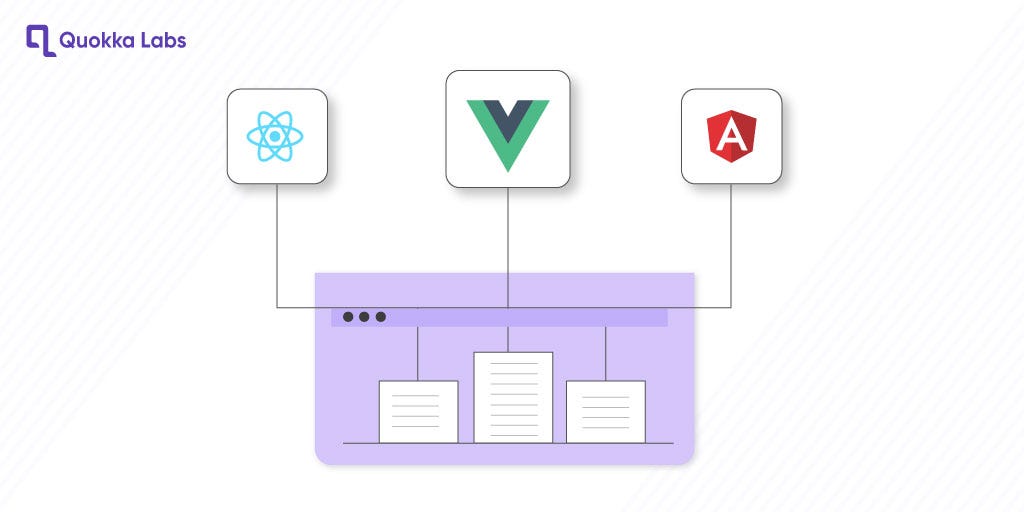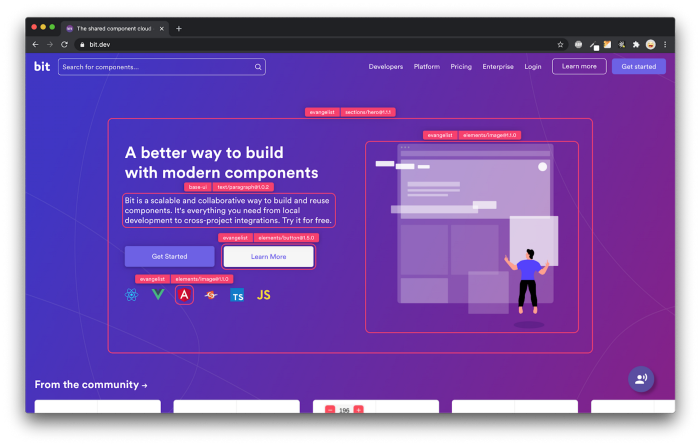This content originally appeared on Bits and Pieces - Medium and was authored by Quokka Labs
The importance of micro front-end architecture for startups, its advantages, and best practices for implementation.

In today’s fast-paced digital world, startups must be agile and flexible to adapt to changing market demands. One of the critical areas that startups need to focus on is the front-end development of their apps. With the increasing demand for scalable front-end app development services, it has become essential for startups to hire front-end developers who can deliver high-quality front-end app development.
Micro front-end Architecture is a new approach to front-end app development recently gaining popularity. It is a scalable solution for startups’ front-end development, allowing for the story of small, independent, and reusable front-end microservices. This approach enables startups to scale their front-end app development quickly and ensures that their apps handle many users and transactions.
In this blog, we will see the importance of micro front-end architecture for startups, its advantages, and the best practices for implementation. We will highlight challenges startups may face while implementing Micro front-end architecture and solutions to overcome them. Startups will understand how micro front-end architecture can help them achieve their front-end development goals. Startups will be able to hire front-end developers.
Advantages of Micro front-end Architecture
Micro front-end architecture offers several advantages, making it an ideal solution for startups’ front-end development. Some of the key advantages are:
Scalability
One of the significant advantages of Micro front-end architecture is its ability to scale front-end development. With this approach, startups can break their front-end app into small, independent, and reusable microservices. It allows them to add new features and functionality to their app without affecting the existing codebase. As a result, startups can scale their front-end app development quickly, ensuring that their apps can handle many users and transactions.
Reusability
Another advantage of Micro front-end Architecture is the reusability of code. Startups can create small, independent microservices that can be reused across different app parts. It reduces the development time and effort required to add new features and functionality to their app. It also allows for better code maintenance and debugging, making it easier for the front-end developer to work on the app.
Improved collaboration:
Micro front-end Architecture allows for better collaboration between front-end developers and other teams, such as back-end developers, designers, and product managers. This approach enables different groups to work on different parts of the app simultaneously without affecting each other’s work. It leads to faster development and deployment of new features and functionality, which is critical for startups.
Overall, micro front-end architecture is a scalable, reusable, and efficient approach to front-end development that startups can benefit from. It allows for better collaboration between different teams, faster growth and deployment of new features, and improved app scalability.
In the next section, we will see the steps and best practices for implementing Micro front-end architecture in a startup’s front-end development process.
Identifying common UI components across your micro-frontends, isolating them, and then using an open-source toolchain like Bit to manage, version, and share them across projects is an elegant, maintainable solution that will help both scalability and reusability, and enable better collaboration between your teams. Find out more here.
Implementing Micro front-end Architecture
Implementing Micro front-end architecture in a startup’s front-end development process can seem daunting, but it can be done quickly with the proper steps and best practices.
Below are some essential steps and best practices for implementing Micro front-end architecture.
Steps to implement Micro front-end Architecture
- Identify the different parts of the app that can be broken down into microservices
- Create small, independent, and reusable microservices for each part of the app
- Use a tool or framework that supports Micro front-end Architecture, such as Single-spa, Microfront-end.js, or Bit.
- Use a service registry to discover and communicate with the different microservices
- Use a load balancer to distribute the traffic among the other microservices
Tools and frameworks available for implementing Micro front-end Architecture
Several tools and frameworks can be used to implement Micro front-end Architecture, such as Single-spa, Microfront-end.js, and Bit. These tools and frameworks provide the necessary infrastructure for creating and managing microservices. They also support communication between the different microservices.
Best practices for implementing Micro front-end Architecture
- Keep microservices small and independent
- Use a service registry to discover and communicate with the different microservices
- Use a load balancer to distribute the traffic among the other microservices
- Use a tool or framework that supports Micro front-end Architecture
- Make sure the microservices are easy to deploy and maintain
- Test the microservices separately before integrating them
- Continuously monitor the performance of the microservices
Implementing Micro front-end architecture can be complex, but by following the proper steps and best practices, startups can ensure a smooth implementation and achieve the desired benefits.
In the next section, we will see the challenges and solutions that startups may face while implementing Micro front-end architecture.
Challenges and Solutions
While Micro front-end architecture offers several advantages for scalable front-end app development services, startups may face some challenges while implementing it. Some of the critical challenges and solutions are listed below.
Challenges faced while implementing Micro front-end Architecture
- Complexity: Breaking the front-end app into small, independent microservices can increase complexity and make it easier for front-end developers to navigate the codebase.
- Communication and coordination: Microservices need to communicate and coordinate with each other. It can be challenging, primarily when different teams work on different microservices.
- Deployment and maintenance: Deploying and maintaining multiple microservices can be challenging and requires a different approach than deploying and maintaining a monolithic app.
Solutions to overcome the challenges
- Keep the microservices small and independent: By keeping them small and independent, startups can reduce the complexity of the codebase and make it easier for front-end developers to navigate.
- Use a service registry: A service registry can discover and communicate with the different microservices. It can simplify communication and coordination between microservices.
- Use a load balancer: A load balancer can distribute the traffic among the different microservices, which can help improve the app’s performance.
- Use a tool or framework that supports Micro front-end Architecture: Tools and frameworks such as Single-spa, Microfront-end.js, and Bit can help to simplify the deployment and maintenance of the microservices.
- Test the microservices separately before integrating them: By testing them separately, startups can ensure that they are working correctly before incorporating them into the app.
- Continuously monitor the performance of the microservices: By continuously monitoring the performance of the microservices, startups can detect and fix any issues before they affect the app’s performance.
Implementing micro front-end architecture can be challenging, but by following the right solutions, startups can overcome these challenges and achieve the desired benefits.
In the next section, we will discuss real-world examples of startups using Micro front-end architecture and the benefits they have achieved.
Case Studies Examples
Micro front-end architecture has been gaining popularity recently, and several startups have already implemented it in their front-end development processes. Here are a few case study examples of startups that have successfully used Micro front-end architecture to scalable front-end app development services:
Company X:
Company X is a startup that offers a SaaS platform for businesses. They implemented Micro front-end architecture in their front-end development process and scaled their app to handle many users and transactions. By breaking their front-end app into small, independent microservices, they could add new features and functionality to their app without affecting the existing codebase. As a result, they were able to improve the performance of their app and provide a better user experience for their customers.
Company Y:
Company Y is a startup that offers an e-commerce platform. They implemented Micro front-end Architecture in their front-end development process and could reuse code across different parts of their app. It reduced the development time and effort required to add new features and functionality to their app. It also allowed for better code maintenance and easier debugging, making it easier for the front-end developer to work on the app.
Company Z:
Company Z is a startup that offers a digital marketplace. They implemented Micro front-end architecture in their front-end development process. By breaking their app into small, independent microservices, they could improve collaboration between different teams and accelerate the development and deployment of new features. It helped the company quickly adapt to changing market demands and improve its app’s performance.
These case studies demonstrate that Micro front-end architecture is a scalable, reusable, and efficient approach to front-end development that startups can benefit from. It allows for better collaboration between different teams, faster growth and deployment of new features, and improved app scalability.
Conclusion: Micro front-end Architecture is a must-have approach for startups
In conclusion, micro front-end architecture is a scalable, reusable, and efficient approach to front-end development that startups can benefit from. It allows for better collaboration between different teams, faster development, and deployment of new features, and improved app scalability. It is a perfect solution for startups looking for scalable front-end app development services and a way to hire front-end developers effectively.
In short, Micro front-end Architecture is a must-have approach for startups looking for scalable front-end app development services and improving their app’s performance. If you are a startup looking to improve your front-end development, consider implementing Micro front-end architecture and hiring a front-end developer with experience in this approach.
Take the first step today and contact us for a consultation on implementing micro front-end architecture in your startup’s front-end development process and hire the right front-end developer for your project!
From monolithic to composable software with Bit

Bit’s open-source tool help 250,000+ devs to build apps with components.
Turn any UI, feature, or page into a reusable component — and share it across your applications. It’s easier to collaborate and build faster.
Split apps into components to make app development easier, and enjoy the best experience for the workflows you want:
→ Micro-Frontends
→ Design System
→ Code-Sharing and reuse
→ Monorepo
Learn more:
- How We Build Micro Frontends
- How we Build a Component Design System
- How to reuse React components across your projects
- 5 Ways to Build a React Monorepo
- How to Create a Composable React App with Bit
Micro Front-End Architecture: The Scalable Solution for Startups’ Front-End Development was originally published in Bits and Pieces on Medium, where people are continuing the conversation by highlighting and responding to this story.
This content originally appeared on Bits and Pieces - Medium and was authored by Quokka Labs
Quokka Labs | Sciencx (2023-02-16T12:19:50+00:00) Micro Front-End Architecture: The Scalable Solution for Startups’ Front-End Development. Retrieved from https://www.scien.cx/2023/02/16/micro-front-end-architecture-the-scalable-solution-for-startups-front-end-development/
Please log in to upload a file.
There are no updates yet.
Click the Upload button above to add an update.
